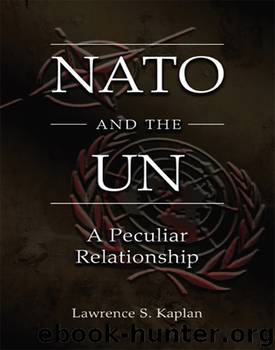Nato and the UN by Lawrence S. Kaplan

Author:Lawrence S. Kaplan
Language: eng
Format: epub
Publisher: University of Missouri Press
NATO Europe and the Balkan Wars, 1991
Responsibility for the calamitous breakup of the federal republic of Yugoslavia rests largely with the leaders of the constituent states. The country itself had been cobbled together after World War I into a kingdom of Serbs, Croats, and Slovenes. This uneasy combination of South Slavs broke down in World War II, as Croatia embraced the Nazi invaders and the Serbs, for the most part, comprised the resistance. The Serb-Croat division arose from their separate identities. The Croats and Slovenes had been part of the Austro-Hungarian empire and Roman Catholic in religion, while the Serbs reflected their heritage as part of the Eastern Orthodox Church under the Ottoman empire. A substantial Muslim population was largely ignored or designated as “Turks” by the Serbs and Croats. Their common language and, after World War II, their membership in the victorious Communist Party under the leadership of a Croat general, Josip Broz (better known as Tito), kept the postwar federation together.
Tito’s death in 1980 precipitated the slow disintegration of both the Communist Party and the republic itself. All the toxic passions of the past, which had separated the Eastern Orthodox Serbs from the Roman Catholic Croats, revived. Nationalist leaders of the two ethnic groups inflamed their followers as each exploited traditional enmities in order to secure their power. Memories of the fascist Croat state that was responsible for the slaughter of thousands of Serbs remained alive among the more populous Serbs who dominated the Yugoslav army. The existence of a large Serb minority in the Krajina sector of Croatia made that area a flashpoint of conflict between the two nations. Given the Serb sense of persecution going back to the Turkish conquest of Serbia in 1389, they would not forget this or any other injustice. The last U.S. ambassador to Yugoslavia observed that “their tragic defect is an obsession with their own history.” They had, he felt, a “lugubrious, paranoid and Serbo-centric view of their own past.”10
The Serbian president was Slobodan Milosevic, a former communist apparatchik turned virulent nationalist who took full advantage of this obsession. Equally intent on following a nationalist part was the Croat president, Franjo Tudjman, who was a former Yugoslav general and like Milosevic a communist leader. If he was the lesser offender, according to Ambassador Warren Zimmermann, it was because he was driven by narrow nationalism and not by a lust for personal power. The only leader supportive of a genuinely federal Yugoslavia was the Bosnian Muslim Alija Izetbegovic, president of Bosnia-Herzegovina. Devout but not an extremist, and no more a democrat than his counterparts in the former Yugoslavia, he recognized the dangers to multiethnic Bosnia facing an expansionist Serbia on the east and an expansionist Croatia on the west. The Muslims comprised the largest portion of the population of Bosnia, some 40 percent, with 32 percent Serbs, and 18 percent Croats.11
The Balkan Wars of the 1990s began on June 25, 1991, when Slovenia and Croatia unilaterally declared independence in the wake of referendums in both states.
Download
This site does not store any files on its server. We only index and link to content provided by other sites. Please contact the content providers to delete copyright contents if any and email us, we'll remove relevant links or contents immediately.
| Automotive | Engineering |
| Transportation |
Whiskies Galore by Ian Buxton(41537)
Introduction to Aircraft Design (Cambridge Aerospace Series) by John P. Fielding(32893)
Small Unmanned Fixed-wing Aircraft Design by Andrew J. Keane Andras Sobester James P. Scanlan & András Sóbester & James P. Scanlan(32579)
Craft Beer for the Homebrewer by Michael Agnew(17938)
Turbulence by E. J. Noyes(7712)
The Complete Stick Figure Physics Tutorials by Allen Sarah(7148)
Kaplan MCAT General Chemistry Review by Kaplan(6603)
The Thirst by Nesbo Jo(6444)
Bad Blood by John Carreyrou(6283)
Modelling of Convective Heat and Mass Transfer in Rotating Flows by Igor V. Shevchuk(6230)
Learning SQL by Alan Beaulieu(6041)
Weapons of Math Destruction by Cathy O'Neil(5842)
Man-made Catastrophes and Risk Information Concealment by Dmitry Chernov & Didier Sornette(5663)
Digital Minimalism by Cal Newport;(5396)
Life 3.0: Being Human in the Age of Artificial Intelligence by Tegmark Max(5193)
iGen by Jean M. Twenge(5166)
Secrets of Antigravity Propulsion: Tesla, UFOs, and Classified Aerospace Technology by Ph.D. Paul A. Laviolette(5002)
Design of Trajectory Optimization Approach for Space Maneuver Vehicle Skip Entry Problems by Runqi Chai & Al Savvaris & Antonios Tsourdos & Senchun Chai(4847)
Electronic Devices & Circuits by Jacob Millman & Christos C. Halkias(4752)
